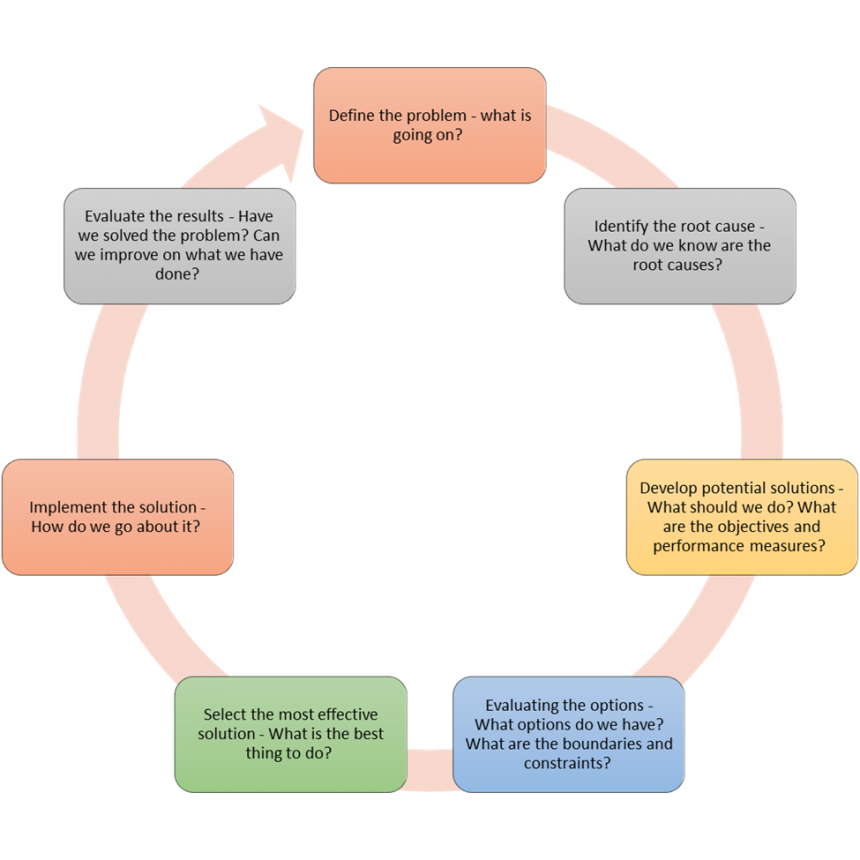One of the most important things for any training organisation is to have a good problem-solving process in place. This allows internal stakeholders to learn from their mistakes and improve their skills.
The seven most effective steps for continuous problem-solving for a training organisation include:
- Define the problem – what is going on?
- Identify the root cause – What do we know are the root causes?
- Develop potential solutions – What should we do? What are the objectives and performance measures?
- Evaluating the options – What options do we have? What are the boundaries and constraints?
- Select the most effective solution – What is the best thing to do?
- Implement the solution – How do we go about it?
- Evaluate the results – Have we solved the problem? Can we improve on what we have done?
Taking each of these steps one at a time, let’s go over them in detail now:
- Define the problem: The first step in solving a problem is to identify and define the issue at hand. This can be done by brainstorming with a team or individual and looking at the problem from different angles. Once the problem is defined, it is important to set goals and objectives for solving it.
- Identify the root cause: The second step is to identify the root cause of the problem. This can be done by conducting research, collecting data, and analyzing information. Once the root cause is identified, it is important to develop a plan of action for addressing it.
- Develop potential solutions: The third step is to develop potential solutions to the problem. This can be done by brainstorming with a team or individual and considering different options such as conducting research. It is important to consider all potential solutions, no matter how far-fetched they may seem at first.
- Evaluating the options: Once all of the potential solutions have been generated, it is important to evaluate each one. This can be done by considering the cost, feasibility and effectiveness of each option.
- Select the most effective solution: After you identify a problem, it’s important to select the most effective solution. The most effective solution is usually the one that best solves the problem while causing the least amount of negative consequences. To select the most effective solution, you’ll need to consider all of your options and evaluate them against your criteria. Once you’ve selected a solution, you’ll need to implement it implement the solution and then monitor its effectiveness.
- Implement the solution: After the problem has been identified and a plan for solving it has been put in place, it is time to implement the solution. This step can involve putting the plan into action, testing the solution to see if it works, and making any necessary adjustments. Once the solution has been implemented, it is important to monitor the situation to make sure that the problem has been solved and that no new problems have arisen. This may require some ongoing tweaking of the solution, but eventually, with patience and perseverance, the problem should be resolved.
- Evaluate the results and outcomes: It is important to take the time to evaluate the results of implementing a solution. This will help to determine if the solution was effective and if any changes need to be made. It is also important to document the results so that future problem-solving efforts can be improved.
As an organisation, you must ensure that:
- everyone in the organisation is aware of the process. This includes both staff and students.
- encourage everyone to share their problems with others. This can help them get feedback and ideas on how to solve the problem.
- have a system in place for tracking problems and solutions. This will help ensure that problems are solved effectively and efficiently.
- celebrate successes! recognise students and staff who have solved problems effectively. This will encourage others to do the same.










